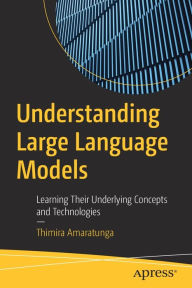PDF Understanding Large Language Models Learning Their Underlying Concepts and Technologies by Thim
Amazon book download ipad Understanding Large Language Models: Learning Their Underlying Concepts and Technologies 9798868800160 (English literature) FB2 ePub RTF

Understanding Large Language Models: Learning Their Underlying Concepts and Technologies Thimira Amaratunga ebook
• Gain insight into how the concepts and approaches of NLP have evolved over the years
• Understand transformer models and attention mechanisms
• Explore different types of LLMs and their applications
• Understand the architectures of popular LLMs
• Delve into misconceptions and concerns about LLMs, as well as how to best utilize them
Who This Book Is For Anyone interested in learning the foundational concepts of NLP, LLMs, and recent advancements of deep learning
In the active field of media, Machine Learning (ML) and Natural Language Processing (NLP), underpinned by Large Language Models (LLMs), act as key catalysts
What are Large Language Models (LLMs)?
Learning Objectives · Understand the concept of Large Language Models (LLMs) and their importance in natural language processing. · Know about
How ChatGPT Works: The Model Behind The Bot
This gentle introduction to the machine learning models that power ChatGPT, will start at the introduction of Large Language Models, dive into the
Harnessing the Power of Large Language Models
These models, typically based on deep learning algorithms, have a vast number of parameters, often ranging from millions to hundreds of billions
Understanding Large Language Models
This book will teach you the underlying concepts of large language models (LLMs), as well as the technologies associated with them.
Natural Language Understanding with Python
Furthermore, this book lays the groundwork for diving into advanced topics such as deep learning and extensive language models. Upon finishing the book, readers
Large Language Models (in 2023)
I gave a talk at Seoul National University. I titled the talk “Large Language Models (in 2023)”. This was an ambitious attempt to summarize
What Are Large Language Models Used For?
Through this method, a large language model learns words, as well as the relationships between and concepts behind them. It could, for example,
Exploring AI challenges: common limitations of large
The development and refinement of large language models, specifically the notable improvement in critical thinking and logical reasoning
What Is a Large Language Model, the Tech Behind
A neural network is a type of machine learning model based on a number of small mathematical functions called neurons. Like the neurons in a
The Full Story of Large Language Models and RLHF
One can say that via this process the model creates an internal representation of language. During the training process, text sequences are
What are large language models?
Training LLMs using unsupervised learning · Transformer processing · Incorporating zero-shot learning · Fine-tuning with supervised learning.
Modified at 2025-06-20 01:11:15